rear view mirror BMW X5 3.0I 2001 Owners Manual
[x] Cancel search | Manufacturer: BMW, Model Year: 2001, Model line: X5 3.0I, Model: BMW X5 3.0I 2001Pages: 223, PDF Size: 2.66 MB
Page 10 of 223
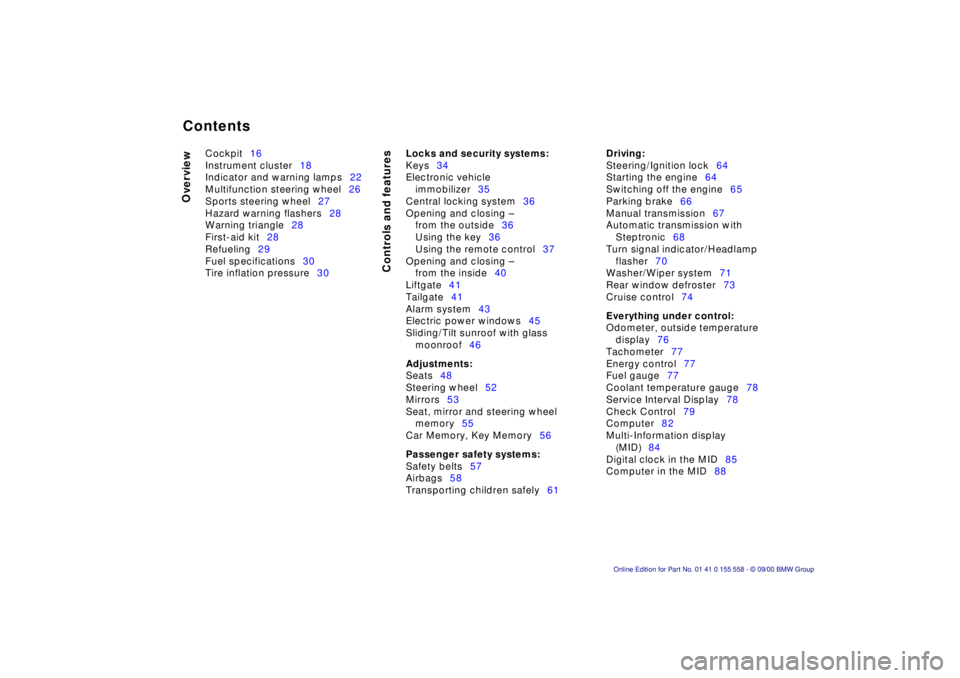
Contents
Overview
Controls and features
Cockpit 16
Instrument cluster 18
Indicator and warning lamps 22
Multifunction steering wheel 26
Sports steering wheel 27
Hazard warning flashers 28
Warning triangle 28
First-aid kit 28
Refueling 29
Fuel specifications 30
Tire inflation pressure 30
Locks and security systems:
Keys34
Electronic vehicle immobilizer 35
Central locking system 36
Opening and closing – from the outside 36
Using the key 36
Using the remote control 37
Opening and closing – from the inside 40
Liftgate 41
Tailgate 41
Alarm system 43
Electric power windows 45
Sliding/Tilt sunroof with glass moonroof 46
Adjustments:
Seats48
Steering wheel 52
Mirrors 53
Seat, mirror and steering wheel memory 55
Car Memory, Key Memory 56
Passenger safety systems:
Safety belts57
Airbags 58
Transporting children safely 61
Driving:
Steering/Ignition lock64
Starting the engine 64
Switching off the engine 65
Parking brake 66
Manual transmission 67
Automatic transmission with Steptronic 68
Turn signal indicator/Headlamp flasher 70
Washer/Wiper system 71
Rear window defroster 73
Cruise control 74
Everything under control:
Odometer, outside temperature
display 76
Tachometer 77
Energy control 77
Fuel gauge 77
Coolant temperature gauge 78
Service Interval Display 78
Check Control 79
Computer 82
Multi-Information display (MID) 84
Digital clock in the MID 85
Computer in the MID 88
Contents
Page 12 of 223
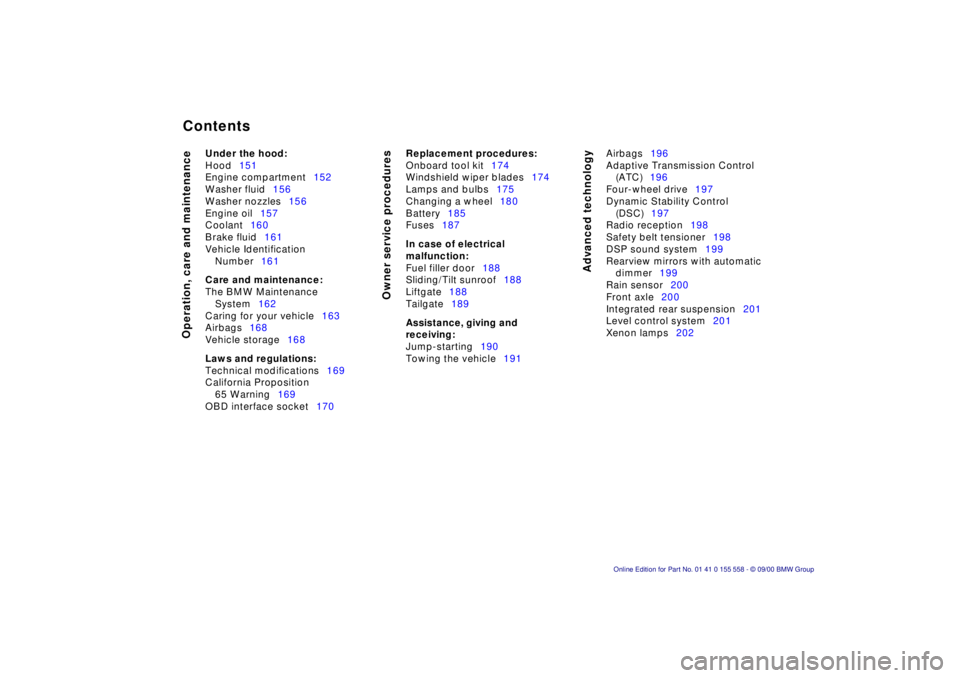
Contents
Operation, care and maintenanceOwner service proceduresAdvanced technology
Under the hood:
Hood 151
Engine compartment 152
Washer fluid 156
Washer nozzles 156
Engine oil 157
Coolant 160
Brake fluid 161
Vehicle Identification Number 161
Care and maintenance:
The BMW Maintenance
System 162
Caring for your vehicle 163
Airbags 168
Vehicle storage 168
Laws and regulations:
Technical modifications 169
California Proposition 65 Warning 169
OBD interface socket 170
Replacement procedures:
Onboard tool kit174
Windshield wiper blades 174
Lamps and bulbs 175
Changing a wheel 180
Battery 185
Fuses 187
In case of electrical
malfunction:
Fuel filler door 188
Sliding/Tilt sunroof 188
Liftgate 188
Tailgate 189
Assistance, giving and
receiving:
Jump-starting 190
Towing the vehicle 191 Airbags
196
Adaptive Transmission Control (ATC) 196
Four-wheel drive 197
Dynamic Stability Control (DSC) 197
Radio reception 198
Safety belt tensioner 198
DSP sound system 199
Rearview mirrors with automatic dimmer 199
Rain sensor 200
Front axle 200
Integrated rear suspension 201
Level control system 201
Xenon lamps 202
Page 43 of 223
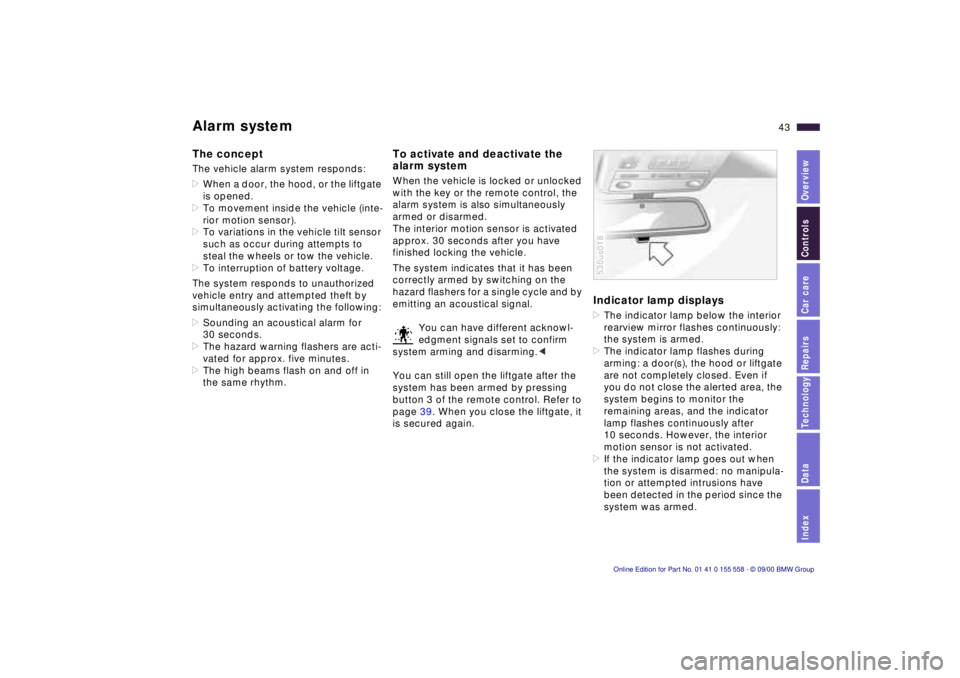
Index
Data
Technology
Repairs
Car care
Controls
Overview
43nAlarm system
The concept
The vehicle alarm system responds:
>When a door, the hood, or the liftgate
is opened.
> To movement inside the vehicle (inte-
rior motion sensor).
> To variations in the vehicle tilt sensor
such as occur during attempts to
steal the wheels or tow the vehicle.
> To interruption of battery voltage.
The system responds to unauthorized
vehicle entry and attempted theft by
simultaneously activating the following:
> Sounding an acoustical alarm for
30 seconds.
> The hazard warning flashers are acti-
vated for approx. five minutes.
> The high beams flash on and off in
the same rhythm.
To activate and deactivate the
alarm system
When the vehicle is locked or unlocked
with the key or the remote control, the
alarm system is also simultaneously
armed or disarmed.
The interior motion sensor is activated
approx. 30 seconds after you have
finished locking the vehicle.
The system indicates that it has been
correctly armed by switching on the
hazard flashers for a single cycle and by
emitting an acoustical signal.
You can have different acknowl-
edgment signals set to confirm
system arming and disarming. <
You can still open the liftgate after the
system has been armed by pressing
button 3 of the remote control. Refer to
page 39. When you close the liftgate, it
is secured again.
Indicator lamp displays
> The indicator lamp below the interior
rearview mirror flashes continuously:
the system is armed.
> The indicator lamp flashes during
arming: a door(s), the hood or liftgate
are not completely closed. Even if
you do not close the alerted area, the
system begins to monitor the
remaining areas, and the indicator
lamp flashes continuously after
10 seconds. However, the interior
motion sensor is not activated.
> If the indicator lamp goes out when
the system is disarmed: no manipula-
tion or attempted intrusions have
been detected in the period since the
system was armed.
530us018
Page 54 of 223

54nMirrors
Interior rearview mirror
To reduce glare from vehicles behind
you when you are driving at night, tilt
the mirror by turning the button.
Lighted vanity mirror
Fold down the sun visor and slide the
cover panel to the side as required.
The mirror lamps operate from ignition
key position 1 and up.
Sun visors
These can be folded down toward the
windshield or swiveled out against the
side windows.
530us030
Interior and exterior rearview
mirror with automatic dimmer
*
By responding to the effects of ambient
light and the glare from following traffic,
these mirrors automatically dim through
an infinitely-variable range.
There are 2 photocells located in the
interior rearview mirror for this purpose.
One photocell (arrow) is in the mirror
glass, while the other is offset some-
what on the back of the mirror.
The mirrors automatically revert to their
clear, undimmed setting whenever you
select "Reverse."
530us031
For trouble-free operation, keep the
photocells clean and do not cover the
area between the interior rearview
mirror and the windshield. Do not
attach any kind of stickers on the wind-
shield in front of the mirror, either.
For an explanation of the electro-
chromic technology used in these
mirrors, refer to page 199.
Page 71 of 223
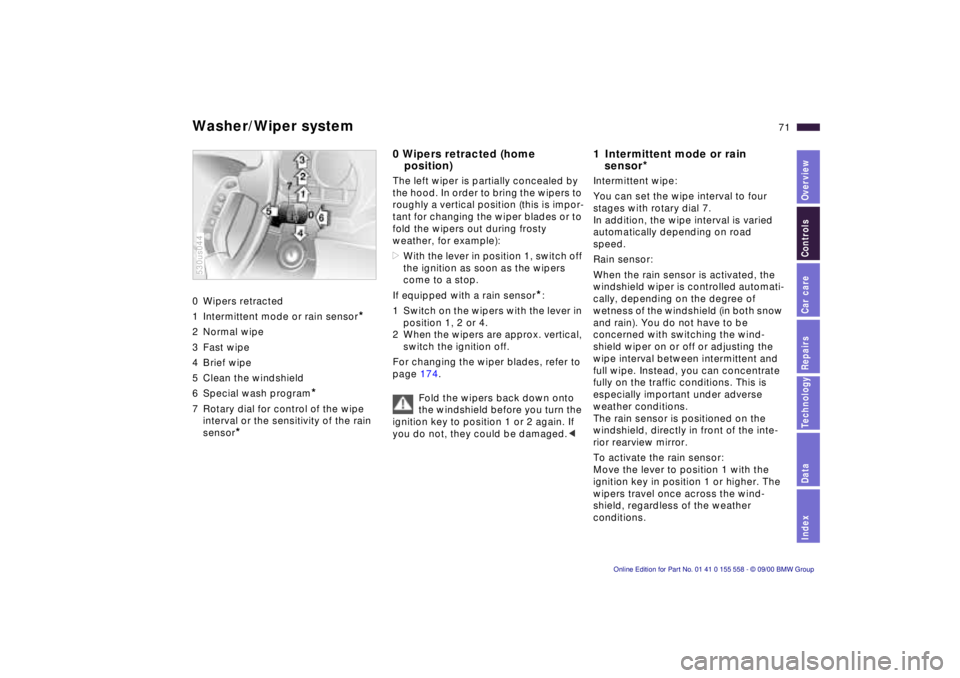
Index
Data
Technology
Repairs
Car care
Controls
Overview
71nWasher/Wiper system
0 Wipers retracted
1 Intermittent mode or rain sensor
*
2 Normal wipe
3 Fast wipe
4 Brief wipe
5 Clean the windshield
6 Special wash program
*
7 Rotary dial for control of the wipe interval or the sensitivity of the rain
sensor
*
530us044
0 Wipers retracted (home position)
The left wiper is partially concealed by
the hood. In order to bring the wipers to
roughly a vertical position (this is impor-
tant for changing the wiper blades or to
fold the wipers out during frosty
weather, for example):
> With the lever in position 1, switch off
the ignition as soon as the wipers
come to a stop.
If equipped with a rain sensor
*:
1 Switch on the wipers with the lever in position 1, 2 or 4.
2 When the wipers are approx. vertical, switch the ignition off.
For changing the wiper blades, refer to
page 174.
Fold the wipers back down onto
the windshield before you turn the
ignition key to position 1 or 2 again. If
you do not, they could be damaged. <
1 Intermittent mode or rain
sensor
*
Intermittent wipe:
You can set the wipe interval to four
stages with rotary dial 7.
In addition, the wipe interval is varied
automatically depending on road
speed.
Rain sensor:
When the rain sensor is activated, the
windshield wiper is controlled automati-
cally, depending on the degree of
wetness of the windshield (in both snow
and rain). You do not have to be
concerned with switching the wind-
shield wiper on or off or adjusting the
wipe interval between intermittent and
full wipe. Instead, you can concentrate
fully on the traffic conditions. This is
especially important under adverse
weather conditions.
The rain sensor is positioned on the
windshield, directly in front of the inte-
rior rearview mirror.
To activate the rain sensor:
Move the lever to position 1 with the
ignition key in position 1 or higher. The
wipers travel once across the wind-
shield, regardless of the weather
conditions.
Page 99 of 223
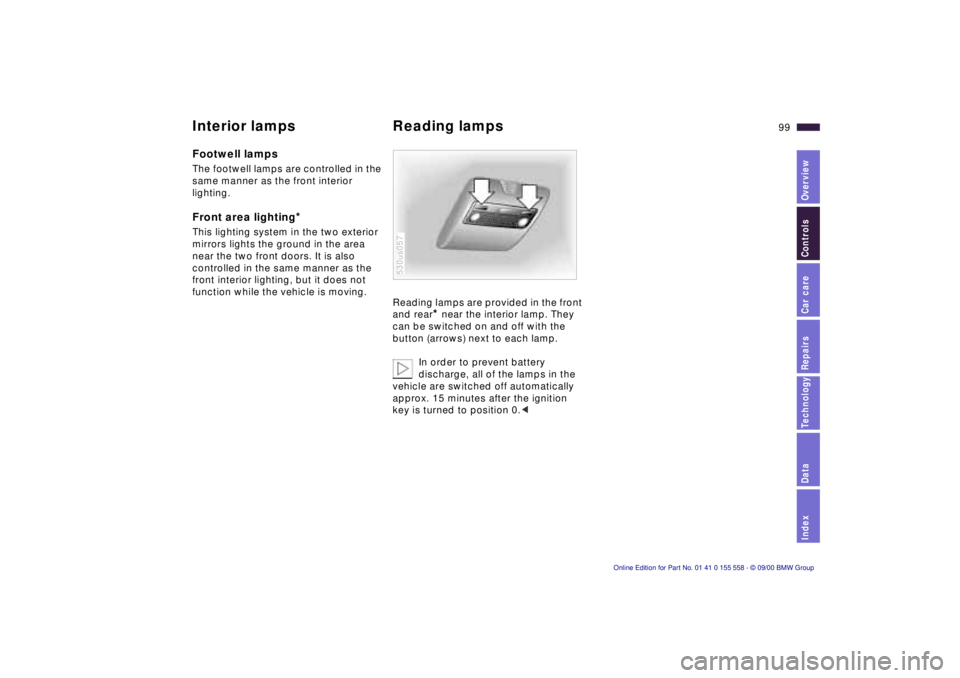
IndexDataTechnologyRepairsCar careControlsOverview
99n
Interior lamps Reading lampsFootwell lampsThe footwell lamps are controlled in the
same manner as the front interior
lighting. Front area lighting
*
This lighting system in the two exterior
mirrors lights the ground in the area
near the two front doors. It is also
controlled in the same manner as the
front interior lighting, but it does not
function while the vehicle is moving.
Reading lamps are provided in the front
and rear
* near the interior lamp. They
can be switched on and off with the
button (arrows) next to each lamp.
In order to prevent battery
discharge, all of the lamps in the
vehicle are switched off automatically
approx. 15 minutes after the ignition
key is turned to position 0.<
530us057
Page 195 of 223
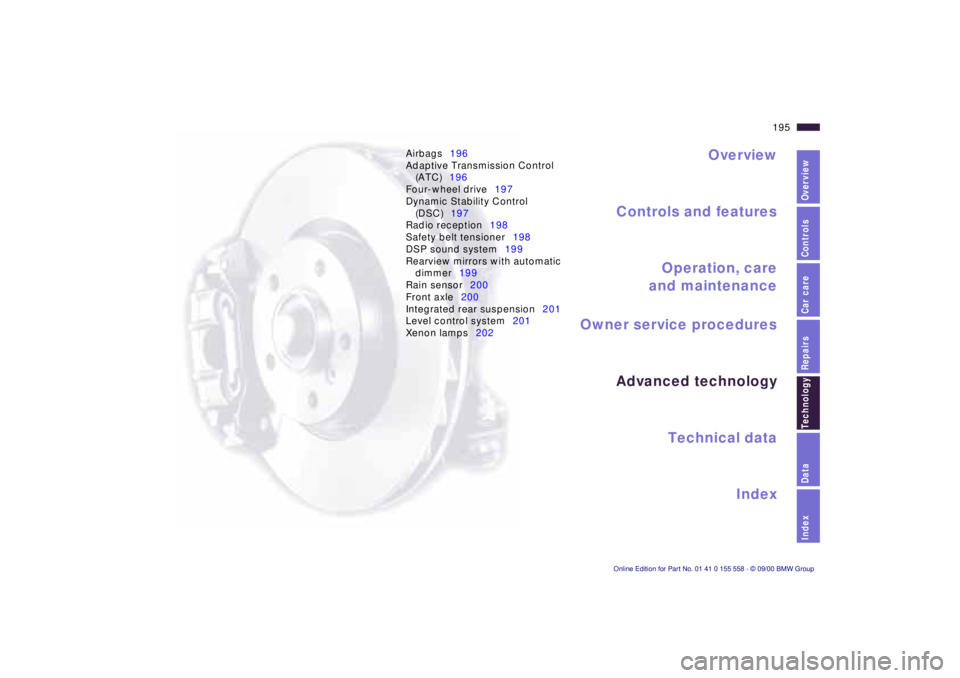
IndexDataTechnologyRepairsCar careControlsOverview
Overview
Controls and features
Operation, care
and maintenance
Owner service procedures
Technical data
Index Advanced technology
195n
Airbags196
Adaptive Transmission Control
(ATC)196
Four-wheel drive197
Dynamic Stability Control
(DSC)197
Radio reception198
Safety belt tensioner198
DSP sound system199
Rearview mirrors with automatic
dimmer199
Rain sensor200
Front axle200
Integrated rear suspension201
Level control system201
Xenon lamps202
Technology
Page 199 of 223
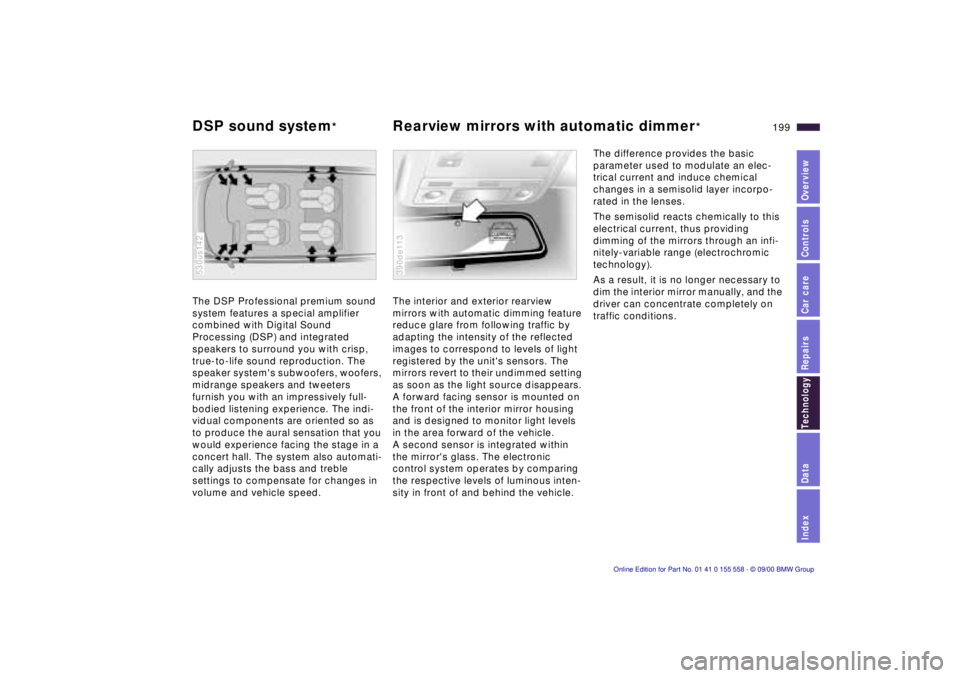
Index
Data
Technology
Repairs
Car care
Controls
Overview
199nDSP sound system* Rearview mirrors with automatic dimmer*
The DSP Professional premium sound
system features a special amplifier
combined with Digital Sound
Processing (DSP) and integrated
speakers to surround you with crisp,
true-to-life sound reproduction. The
speaker system's subwoofers, woofers,
midrange speakers and tweeters
furnish you with an impressively full-
bodied listening experience. The indi-
vidual components are oriented so as
to produce the aural sensation that you
would experience facing the stage in a
concert hall. The system also automati-
cally adjusts the bass and treble
settings to compensate for changes in
volume and vehicle speed.
530us142
The interior and exterior rearview
mirrors with automatic dimming feature
reduce glare from following traffic by
adapting the intensity of the reflected
images to correspond to levels of light
registered by the unit's sensors. The
mirrors revert to their undimmed setting
as soon as the light source disappears.
A forward facing sensor is mounted on
the front of the interior mirror housing
and is designed to monitor light levels
in the area forward of the vehicle.
A second sensor is integrated within
the mirror's glass. The electronic
control system operates by comparing
the respective levels of luminous inten-
sity in front of and behind the vehicle.
390de113
The difference provides the basic
parameter used to modulate an elec-
trical current and induce chemical
changes in a semisolid layer incorpo-
rated in the lenses.
The semisolid reacts chemically to this
electrical current, thus providing
dimming of the mirrors through an infi-
nitely-variable range (electrochromic
technology).
As a result, it is no longer necessary to
dim the interior mirror manually, and the
driver can concentrate completely on
traffic conditions.
Page 214 of 223
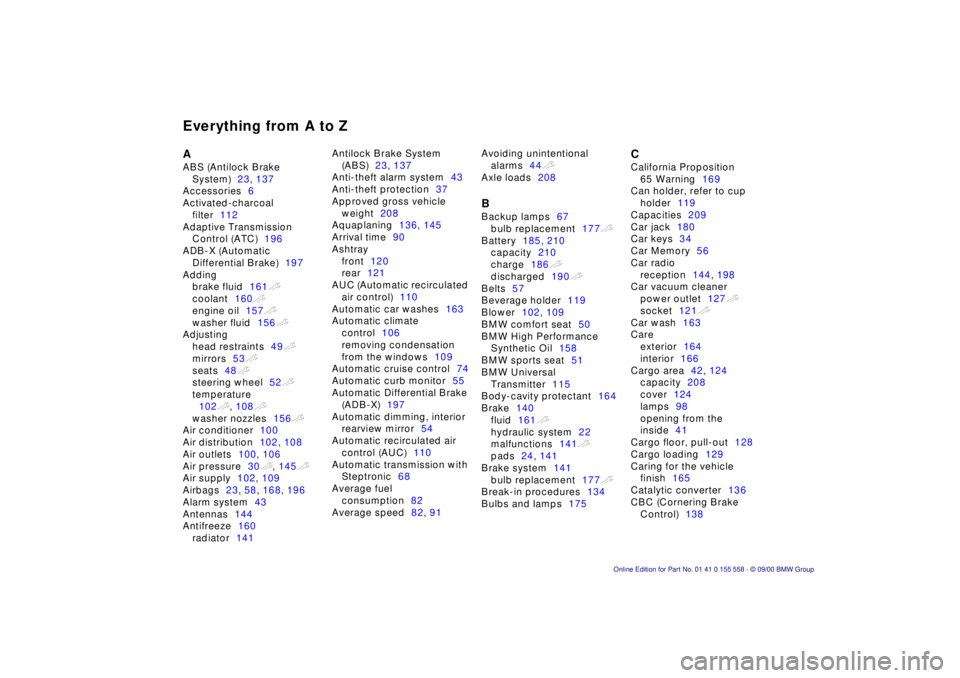
Everything from A to Z
A
ABS (Antilock Brake System) 23, 137
Accessories 6
Activated-charcoal filter 112
Adaptive Transmission Control (ATC) 196
ADB-X (Automatic Differential Brake) 197
Adding brake fluid 161t
coolant 160t
engine oil 157t
washer fluid 156t
Adjusting head restraints 49t
mirrors 53t
seats 48t
steering wheel 52t
temperature 102 t, 108 t
washer nozzles 156t
Air conditioner 100
Air distribution 102, 108
Air outlets 100, 106
Air pressure 30t , 145 t
Air supply 102, 109
Airbags 23, 58 , 168 , 196
Alarm system 43
Antennas 144
Antifreeze 160
radiator 141 Antilock Brake System
(ABS) 23, 137
Anti-theft alarm system 43
Anti-theft protection 37
Approved gross vehicle weight 208
Aquaplaning 136, 145
Arrival time 90
Ashtray front 120
rear 121
AUC (Automatic recirculated air control) 110
Automatic car washes 163
Automatic climate control 106
removing condensation
from the windows 109
Automatic cruise control 74
Automatic curb monitor 55
Automatic Differential Brake (ADB-X) 197
Automatic dimming, interior rearview mirror 54
Automatic recirculated air
control (AUC) 110
Automatic transmission with Steptronic 68
Average fuel consumption 82
Average speed 82, 91 Avoiding unintentional
alarms 44t
Axle loads 208
B
Backup lamps 67
bulb replacement 177t
Battery 185, 210
capacity 210
charge 186t
discharged 190t
Belts 57
Beverage holder 119
Blower 102, 109
BMW comfort seat 50
BMW High Performance Synthetic Oil 158
BMW sports seat 51
BMW Universal Transmitter 115
Body-cavity protectant 164
Brake 140
fluid 161t
hydraulic system 22
malfunctions 141t
pads 24, 141
Brake system 141
bulb replacement 177t
Break-in procedures 134
Bulbs and lamps 175
C
California Proposition
65 Warning 169
Can holder, refer to cup holder 119
Capacities 209
Car jack 180
Car keys 34
Car Memory 56
Car radio reception 144, 198
Car vacuum cleaner power outlet 127t
socket 121t
Car wash 163
Care exterior 164
interior 166
Cargo area 42, 124
capacity 208
cover 124
lamps 98
opening from the
inside 41
Cargo floor, pull-out 128
Cargo loading 129
Caring for the vehicle finish 165
Catalytic converter 136
CBC (Cornering Brake Control) 138
Page 216 of 223
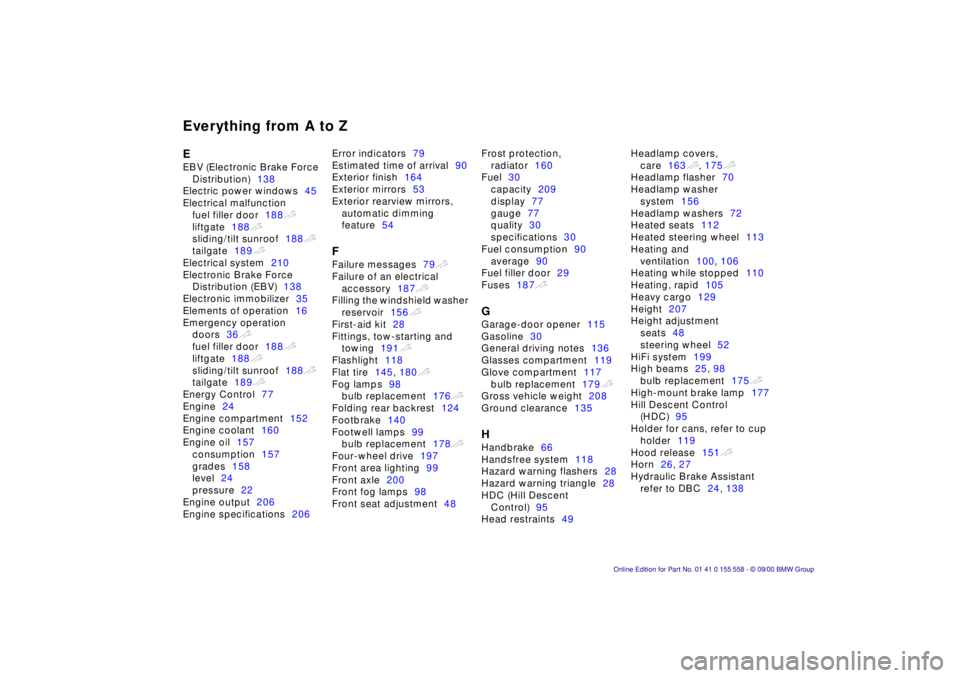
Everything from A to Z
E
EBV (Electronic Brake Force Distribution) 138
Electric power windows 45
Electrical malfunction fuel filler door 188t
liftgate 188t
sliding/tilt sunroof 188t
tailgate 189t
Electrical system 210
Electronic Brake Force Distribution (EBV) 138
Electronic immobilizer 35
Elements of operation 16
Emergency operation doors 36t
fuel filler door 188t
liftgate 188t
sliding/tilt sunroof 188t
tailgate 189t
Energy Control 77
Engine 24
Engine compartment 152
Engine coolant 160
Engine oil 157
consumption 157
grades 158
level 24
pressure 22
Engine output 206
Engine specifications 206Error indicators
79
Estimated time of arrival 90
Exterior finish 164
Exterior mirrors 53
Exterior rearview mirrors, automatic dimming
feature 54
F
Failure messages 79t
Failure of an electrical accessory 187t
Filling the windshield washer reservoir 156t
First-aid kit 28
Fittings, tow-starting and towing 191t
Flashlight 118
Flat tire 145, 180 t
Fog lamps 98
bulb replacement 176t
Folding rear backrest 124
Footbrake 140
Footwell lamps 99
bulb replacement 178t
Four-wheel drive 197
Front area lighting 99
Front axle 200
Front fog lamps 98
Front seat adjustment 48Frost protection,
radiator 160
Fuel 30
capacity 209
display 77
gauge 77
quality 30
specifications 30
Fuel consumption 90
average 90
Fuel filler door 29
Fuses 187t
G
Garage-door opener 115
Gasoline 30
General driving notes 136
Glasses compartment 119
Glove compartment 117
bulb replacement 179t
Gross vehicle weight 208
Ground clearance 135
H
Handbrake66
Handsfree system 118
Hazard warning flashers 28
Hazard warning triangle 28
HDC (Hill Descent Control) 95
Head restraints 49Headlamp covers,
care 163t, 175 t
Headlamp flasher 70
Headlamp washer system 156
Headlamp washers 72
Heated seats 112
Heated steering wheel 113
Heating and ventilation 100, 106
Heating while stopped 110
Heating, rapid 105
Heavy cargo 129
Height 207
Height adjustment seats 48
steering wheel 52
HiFi system 199
High beams 25, 98
bulb replacement 175t
High-mount brake lamp 177
Hill Descent Control (HDC) 95
Holder for cans, refer to cup holder 119
Hood release 151t
Horn 26, 27
Hydraulic Brake Assistant refer to DBC 24, 138